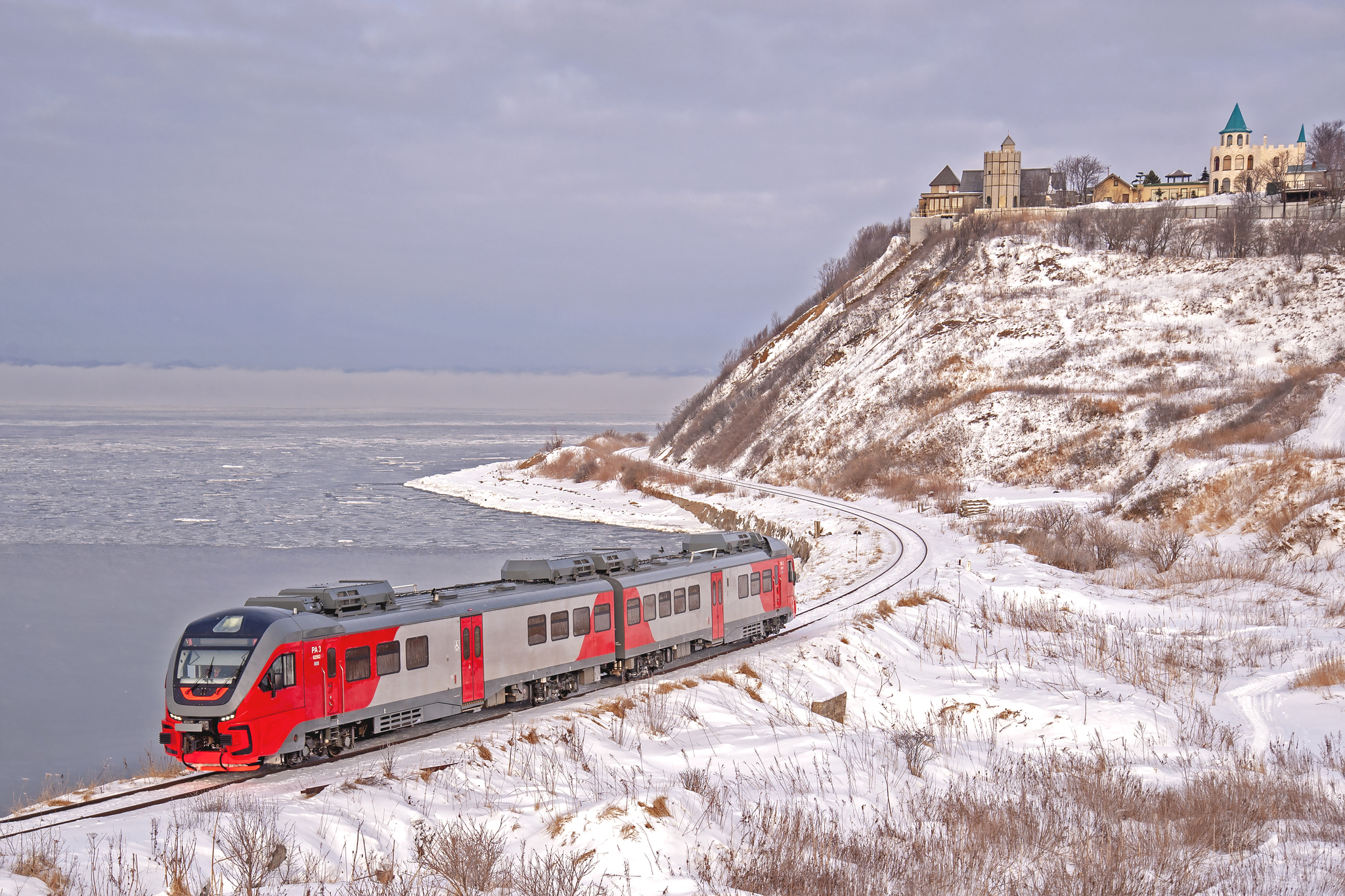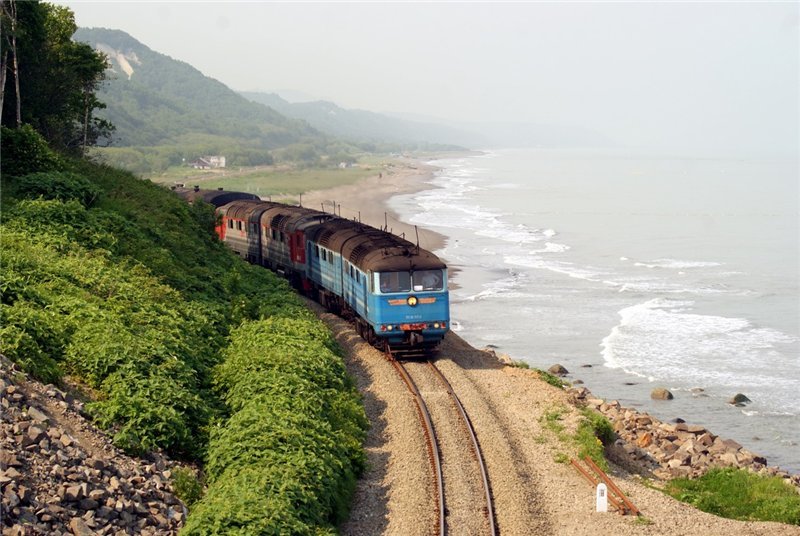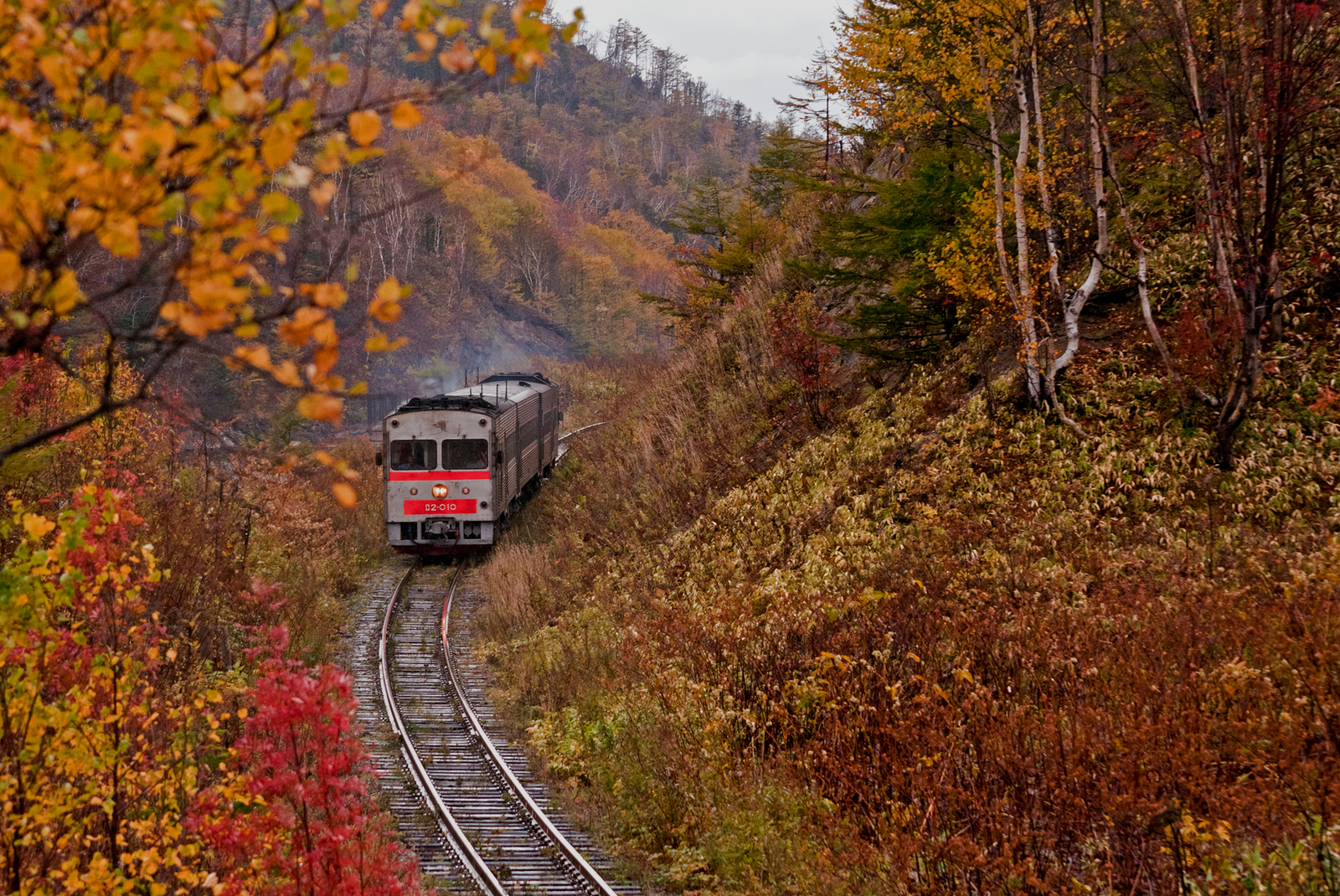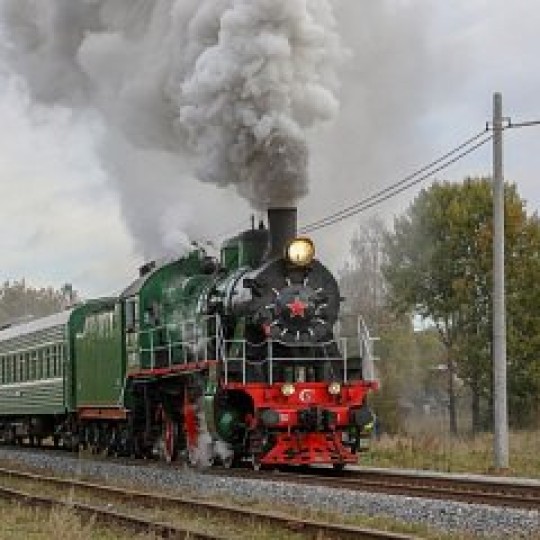Железные дороги Сахалина или одна из уникальных достопримечательностей острова
Современный Сахалин – это далёкий и изолированный регион нашей страны, где при движении вдоль моря можно увидеть большие лопухи, горный рельеф и, к сожалению, разруху. Именно богатство ресурсами предопределило появление на Сахалине железнодорожного сообщения, а подчинение Японии в течение 40 лет наложило соответствующий отпечаток на её облик. До сих пор эта дорога узкая, но выдерживающая значительные перевозки при большом количестве сложных участков: почти на горных обрывах и рядом с морем.

СПРАВКА! Длина жд-путей составляет 805 км. Строительство велось с 1907 по 1979 гг. Города, которые она захватывает: Южно-Сахалинск, Холмск, Поронайск, Корсаков.
При возможной добыче нефти и газа, большинство поселений на острове не могут похвастаться благополучием. Крупного производства почти не осталось. И среди этой печальной картины выделяется лишь железная дорога, хотя за целые сутки на ней можно увидеть редкий грузовой или пассажирский составы. Но руководство ЖД уже начало работу по превращению её в стандартную российскую колею, надеясь, видимо, на будущую востребованность.
Пока ЖД окончательно не приложило руку ребрендинга на эту дорогу, и пока по ней ходят забавные японские поезда, не поленитесь проехать по ней вдоль моря. Вечером, когда солнце опускается за морской горизонт, оторваться от окна будет невозможно. Виляя, поезд провезёт ещё и через дикие заросли бамбука. А потом обязательно прочтите историю создания железной дороги, в момент которой строились фантастические планы со взлётами и падениями.
СПРАВКА! Что посмотреть:
- линии капской колеи по берегу Охотского и Японского морей;
- «Чёртов мост», «Ведьмин мост» и тоннели на бывшей линии Южно-Сахалинск – Холмск;
- музей истории железной дороги.
Транспортная сеть на Сахалине начала развиваться ещё в момент подчинения Японии его южной части (губернаторство Карафуто). До военного конфликта между Россией и Японией в начале XX века остров был пунктом ссылки, а поселения образовывались вокруг мест пребывания каторжников. Нормальной дороги не было – её постоянно размывало дождями, сообщение с внешним миром очень страдало. Рабочая деятельность людей заключалась в добыче угля. Небольшой участок первой железной дороги появился именно на шахтах.

Порсмутский мирный договор определил передачу власти от военных к мирному японскому правительству, что ускорило освоение приобретённой территории. Тем, кто готов был переехать на остров, предлагали земли с обязательным условием их обработки. Сахалин славился обширными лесами, полезными ископаемыми, плодородными землями и пресной водой. То есть возможностей для жизни и развития хозяйства было немало. Японцы с радостью воспользовались этим шансом: с 1905 года за 40 лет население Карафуто (сейчас Южно-Сахалинск) выросло до 400 тысяч человек.
К началу XX века Япония могла похвастаться успехами в построении горных железнодорожных сообщений с колеёй 1067 мм (капская колея). Дорога стала перевозить пассажиров, постепенно расширяться на север и проходила через самые плодородные земли, на которых удобно было жить переселенцам.
Чуть позже появился план распространения жд-линии на западное побережье, которое впоследствии соединили с восточным. Стройка продолжалось 7 лет, длина ветки составила 84 км. В ходе работ появились 15 тоннелей, 35 мостов и несколько противолавинных галерей. Но грандиозным строением стало пересечение дороги с Южно-Сахалинским хребтом. Дорогу, которая проходила по долине ручья, подняли выше, то есть фактически это было пересечение самой себя. Для этого были вырыты два тоннеля, которые соединил мост, названный «Чёртовым». Открыли этот участок для движения в 1928 году.
Конечно, такая скорость строительства достигались за счёт практически рабского труда. С молчаливого согласия правительства, частные строительные компании заманивали выгодными условиями бедные слои населения. Такая рабочая сила нещадно эксплуатировалась, а обещанные денежные вознаграждения не выплачивалась. В момент стройки погибло немало людей.
К 1945 году на юге Сахалина железнодорожное сообщение было развито на порядок лучше, чем на севере. СССР с 1925 года предпринимало попытки начать строительство транссахалинской магистрали от Александровска до Охи (центр нефтедобычи). Однако завершить работы так и не удалось из-за ограниченного финансирования в условиях надвигающихся военных конфликтов. Новая русско-японская война ускорила продление путей в сторону Поронайска (восточная магистраль), но японцам в борьбе с СССР это не помогло.
После окончания ВОВ на Сахалине, который вернулся в состав России, началось активное восстановление хозяйства, в том числе встал вопрос и о судьбе японской железной дороги. Японские капсульные колеи остались только по причине необходимости скорого налаживания транспортных связей. Но тут появилась новая проблема – обслуживание дороги. Советские переселенцы столкнулись с незнанием принципа работы японских конструкций, а в условиях природных катаклизмов проблема стала ещё острее. И ко всему этому добавлялась удалённость от главного правительства страны, из-за чего решения принимались очень долго и слабо финансировались.
Но постепенно местные жители наладили свой быт и работоспособность железной дороги. Но важные проекты Сахалин увидел лишь в 70-80-е гг. До этого была построена узколейка Оха-Катангли (200 км) до нефтнегазовых районов. Правда, на строительстве были опять задействованы каторжники, состоящие из заключённых. Японские паровозы постепенно заменились новыми отечественными тепловозами. Запущена паромная переправа Ванино – Холмск.

В момент перестройки железнодорожная система Сахалина была полностью заброшена. Закрытыми оказались многие участки, мосты, тоннели и противообвальные галереи, значительно сокращено пассажирское движение. С 2000-х на неё снова обратили внимание, перешив колею на стандартную российскую. К настоящему времени 60% путей обновлены. Но пока не обновили всю систему, сахалинские железные дороги всё еще являются уникальной достопримечательностью города. Из Южно-Сахалинска осуществляет движение флагманский поезд №1 до Ногликов. У Холмска работают японские дизельные поезда Д2. При поездке в Томари на пригородном поезде из окна откроется вид на море, которое почти прикасается к путям. При тёплой погоде хорошим решением будет купить билет на рейс из Холмска до конечной станции 77 км ПК 9 и прогуляться пешком вдоль старых рельс немного вперёд к Чёртову мосту.
Увы, но поддержка одной из самых красивых достопримечательностей Сахалина не финансируется властями, но пока ещё остаётся в хорошем состоянии.









